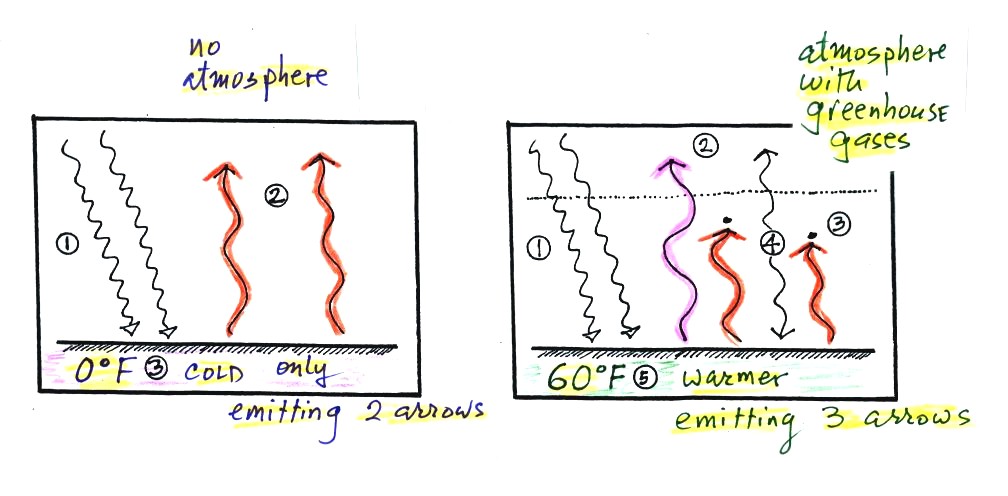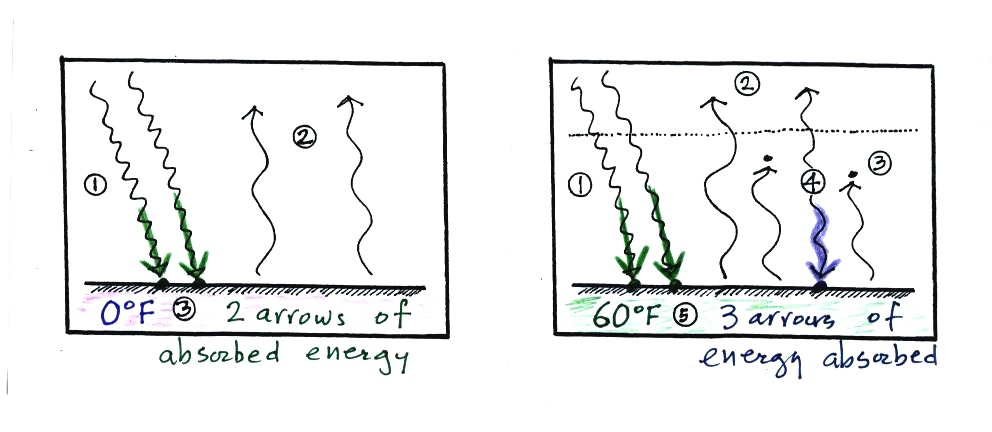Here's another
explanation.
At left the ground
is getting 2 units of energy. At right it is getting three, the
extra one is coming from the atmosphere. Doesn't it make sense
that ground that absorbs 3 units of energy will be warmer than ground
that is only absorbing 2?
In
our simplified explanation of the greenhouse effect we assumed that
100% of the sunlight arriving at the earth passed through the
atmosphere and got absorbed at the ground. Next we will look at how
realistic that assumption is.

The bottom figure
above shows that in reality only about 50% of the incoming sunlight
gets absorbed at the ground.
About 20% of the incoming sunlight is absorbed by gases in the
atmosphere. Sunlight is a
mixture of UV, VIS, and IR light.
Ozone and oxygen will absorb a lot of the UV (though there isn't much
UV in sunlight) and greenhouse gases will absorb some of the IR
radiation in sunlight (Roughly half of sunlight is IR light).
The remaining 30% of the incoming sunlight is reflected back into
space
(by the ground, clouds, even air molecules).
Next we
will look at our simplified version of radiative equilibrium and a more
realistic picture of the earth's energy budget. The figure was
redrawn after class, some of the colors may have changed.

The lower part of the figure is
pretty complicated. It
would be
difficult to start with this figure and find the greenhouse effect in
it. However if you understand the upper figure, you should be
able to find and understand the corresponding parts in the lower figure.
In the top figure you should recognize the incoming sunlight
(green),
IR emitted by the ground that passes through the atmosphere (pink), IR
radiation emitted by the ground that is absorbed by greenhouse gases in
the atmosphere (orange) and IR radiation emitted by the atmosphere
(dark blue). Using the colors you can find each of these parts of
the energy budget in the bottom figure. Notice that conduction,
convection, and latent heat energy transport are needed to bring the
overall energy budget into balance. Click here to see a more detailed
check to be sure everything is in energy balance.
We'll wrap
up the section on radiative equilibrium and the atmospheric greenhouse
effect and start some new material today.
You can
use the simplified picture of radiative equilibrium to understand the
effects of clouds on nighttime low and
daytime high temperatures. You'll find this discussed on pps 72a
and
72b in the Classnotes.

Here's the simplified picture of
radiative equilibrium (something
you're probably getting pretty tired of seeing). By now you
should be able to identify each of the colored arrows in the figure
above and explain what they represent.
The two pictures below show what happens at night when you remove
the
two green rays of incoming sunlight.
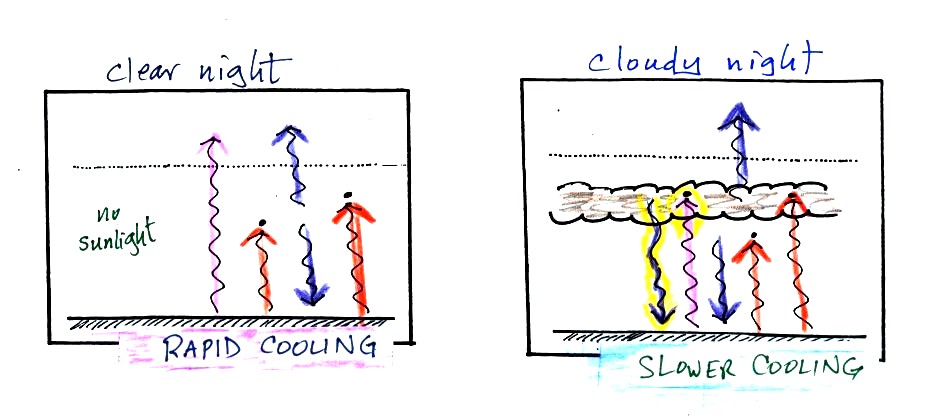
The picture on the left shows a
clear night. The ground is losing
3
arrows of energy and getting one back from the atmosphere. That's
a
net loss of 2 arrows. The ground cools rapidly and gets cold
during
the night.
A cloudy night is shown at right. Notice the effect of the
clouds.
Clouds are good absorbers
of infrared
radiation. If we could see IR light,
clouds would appear black, very different from what we are used
to (because clouds also emit IR light, if we could see IR light the
clouds might also
glow). Now none of
the IR radiation emitted by the ground passes through the atmosphere
into space. It is all absorbed either by greenhouse gases or by
the
clouds. Because the clouds and atmosphere are now absorbing 3
units of
radiation they must emit 3 units: 1 goes upward into space, the other 2
downward to the ground. There is now a net loss at the ground of
only
1 arrow.
The ground won't cool as quickly and won't get as cold on a cloudy
night as it does on a clear night. That makes for nice early
morning bicycle rides this time of the year.
The next two figures compare clear and cloudy days.
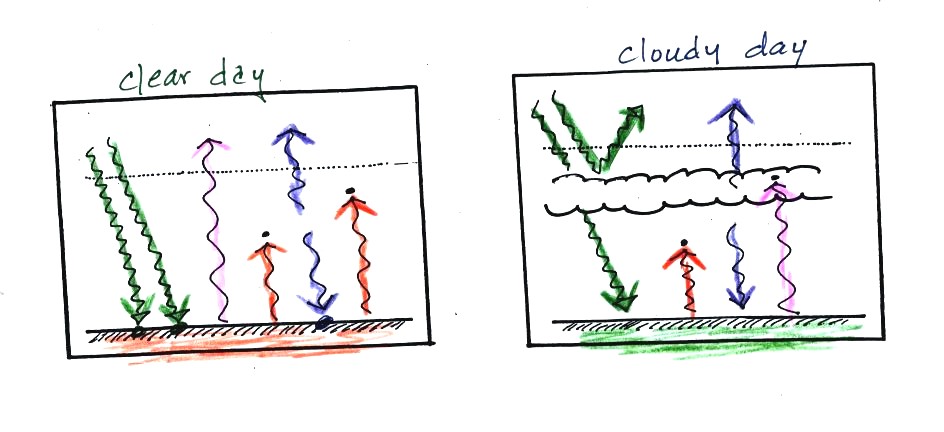
Clouds are good reflectors
of visible
light. The effect of this is to
reduce the amount of sunlight energy reaching the ground in the right
picture. With less sunlight being absorbed at the ground, the
ground
doesn't need to get as warm to be in energy balance.
It is generally cooler during the day on a cloudy day than on a
clear
day.
Clouds raise the nighttime minimum temperature and lower the
daytime
maximum temperature.
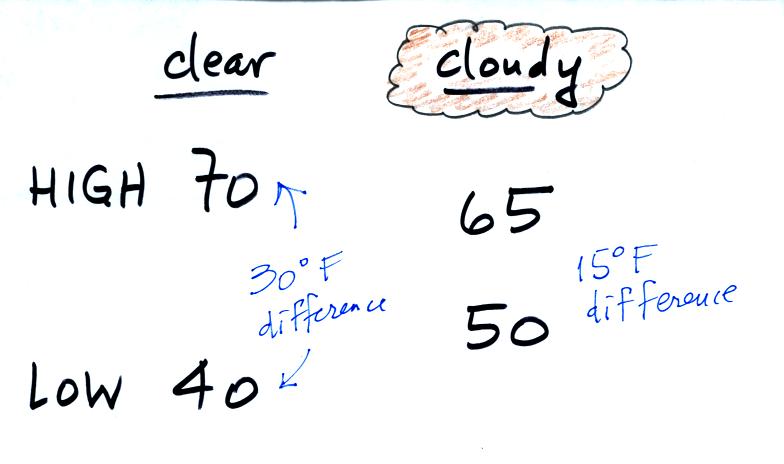
Typical daytime highs and nighttime
lows in Tucson for this
time of year. Note how the clouds reduce the daily range of
temperature.
We'll use
our simplified representation of radiative equilibrium to understand
enhancement of the greenhouse effect and global warming.

The figure (p. 72c in the
photocopied Class Notes) on the
left
shows
energy balance on the earth
without
an atmosphere (or with an atmosphere that doesn't contain greenhouse
gases). The ground achieves energy balance by emitting only 2
units of energy to balance out what it is getting from the sun.
The ground wouldn't need to be
very warm to do this.
If you add an atmosphere and greenhouse gases, the atmosphere will
begin to absorb some of the outgoing IR radiation. The atmosphere
will also begin to emit IR radiation, upward into space and downard
toward the ground. After a period of adjustment you end up with a
new energy balance. The ground is warmer and is now emitting 3
units of energy even though it is only getting 2 units from the
sun. It can do this because it gets a unit of energy from the
atmosphere.
In the right figure the concentration of greenhouse gases has
increased
even more (due to human activities). The earth would find a new
energy balance. In this case the ground would be warmer and would
be emitting 4 units of energy, but still only getting 2 units from the
sun. With more greenhouse gases, the atmosphere is now able to
absorb 3
units of the IR emitted by the ground. The atmosphere sends 2
back to the ground and 1 up into space.
The next figure shows a common misconception about the cause of
global
warming.
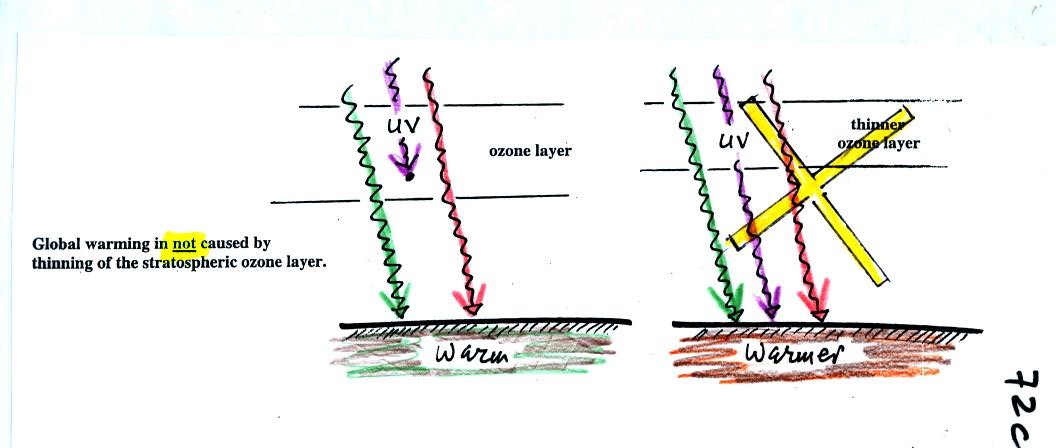
Many people know that sunlight
contains UV light and that
the ozone
absorbs much of the dangerous type of high energy radiation.
People also know that release of chemicals such as CFCs are destroying
stratospheric ozone and letting some of this UV light reach the
ground. That is all
correct.
They then conclude that it is
this additional UV energy reaching the ground that is causing the globe
to warm. This
is not correct. There isn't much UV light in sunlight in
the
first place and the small amount of additional UV light reaching the
ground won't be enough to cause global warming. It will cause
cataracts and skin cancer and those kinds of problems but not global
warming.
We spent
the last few minutes in class watching a short video showing Bertrand
Piccard and Brian Jones making the first trip around the global nonstop
in a balloon. They were competing against a British
balloon. The notes shown in class are below.
You'll see two balloons in this video
The first is the Cable & Wireless balloon with
Andy Elson & Colin Prescot
(Elson had at one time been Piccard's partner)
They set off on Feb. 17, 1999 from Spain
and have a 10 day lead over the Swiss balloon
The 2nd balloon is the Breitling Orbiter 3 with
Bertrand Piccard & Brian Jones
they launch on March 1, 1999.
